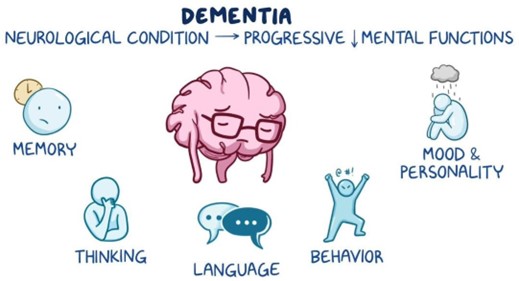A client is showing early signs of dementia. The client's spouse asks, "What may I expect next?" What is the nurse's best response?
"He may begin to try to cover recognition of his memory loss by creating events."
"He may have difficulty in a motor skill such as walking."
"The inability to communicate with speech comes immediately after the early signs."
"He may not recognize you and other people who have been in his life."
The Correct Answer is A
A. "He may begin to try to cover recognition of his memory loss by creating events." As
dementia progresses, individuals may experience confabulation, which involves creating false memories to compensate for memory loss. This is a common symptom seen in the middle stages of dementia.
B. "He may have difficulty in a motor skill such as walking." While motor skills may be affected in the later stages of dementia, it is not typically one of the early signs.
C. "The inability to communicate with speech comes immediately after the early signs." This statement is not accurate. Communication difficulties may occur in later stages, but it is not an immediate progression from early signs.
D. "He may not recognize you and other people who have been in his life." This symptom, known as agnosia, may occur in later stages of dementia, but it is not one of the early signs.

Nursing Test Bank
Naxlex Comprehensive Predictor Exams
Related Questions
Correct Answer is C
Explanation
A) Incorrect. Isolating the client in his room may escalate the situation or make the client feel isolated and misunderstood.
B) Incorrect. Asking the client to stop talking may be perceived as confrontational and could potentially agitate the client further.
C) Correct. Speaking slowly and in a quiet voice can help the client focus and may reduce the flight of ideas. This calm approach can be grounding for the client.
D) Incorrect. Encouraging the client to talk more may exacerbate the flight of ideas and the manic state.
Correct Answer is C
Explanation
A) Incorrect. Thyroxine is a hormone produced by the thyroid gland and is not directly implicated in the etiology of schizophrenia.
B) Incorrect. Erythropoietin is a hormone that stimulates the production of red blood cells and is not directly implicated in the etiology of schizophrenia.
C) Correct. Glutamate, an excitatory neurotransmitter, has been implicated in the development of schizophrenia. Abnormalities in glutamate signaling have been identified in individuals with schizophrenia.
D) Incorrect. While serotonin abnormalities have been associated with mood disorders such as depression, they are not considered a primary factor in the etiology of schizophrenia.
Whether you are a student looking to ace your exams or a practicing nurse seeking to enhance your expertise , our nursing education contents will empower you with the confidence and competence to make a difference in the lives of patients and become a respected leader in the healthcare field.
Visit Naxlex, invest in your future and unlock endless possibilities with our unparalleled nursing education contents today
Report Wrong Answer on the Current Question
Do you disagree with the answer? If yes, what is your expected answer? Explain.
Kindly be descriptive with the issue you are facing.
